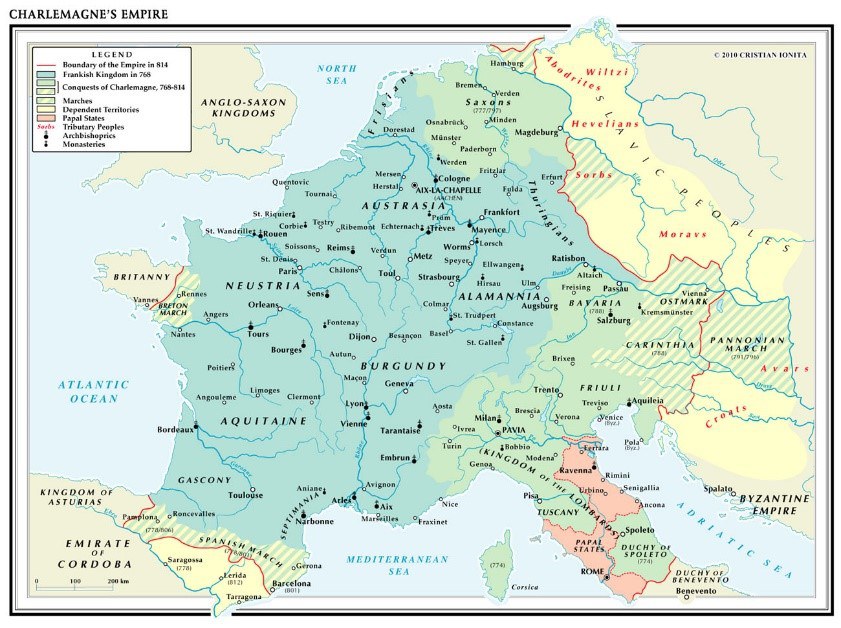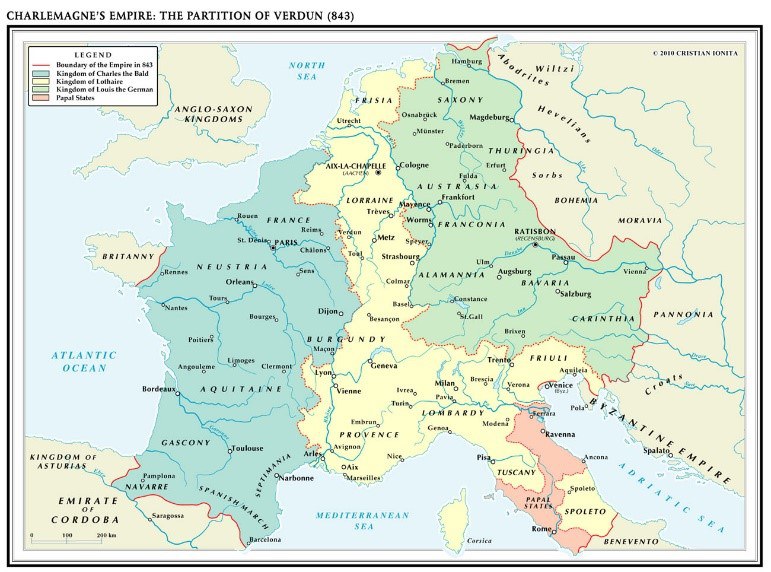The Creation of France
Chapter 2 : The Merovingians and Carolingians
When the Western Roman Empire collapsed in the late sixth century, a legion of small kingdoms and territories grew up, ruled by the Franks, Goths, Visigoths and other Germanic tribes. The first Frankish king to accept Catholic Christianity, Clovis (d. 511), had a base near Tours. He expanded his territory hugely, and incorporated Paris. Clovis’ territories are generally called Neustria, based around Paris and Austrasia (modern day Benelux and north Germany). There were also Burgundy – central west and south-west of modern France - and part of modern Switzerland, Aquitaine and Gascony (see Figure 1).

Brittany was never included in this Merovingian empire, although it may have acknowledged the Merovingians as overlords.
Clovis’ descendants continued the time-honoured tradition of fighting amongst themselves and occasionally banding together to capture new territories. The last important Merovingian king was Dagobert I (r. 629 – 638 AD). Power began to be wielded, not by the kings, but by the mayors of the royal palace. Pepin of Heristal, one of these mayors, built up a power base in Austrasia, although he was viewed with suspicion by the Neustrians.
Pepin’s illegitimate son, Charles Martel (686 – 741), was the next great Frankish king. Requested by Pope Gregory III to help drive the encroaching Saracens out of Europe, he reunited the old Frankish kingdoms, including Aquitaine.
After various disputes in the next generation, Charles Martel’s grandson, known to history as Charlemagne (c. 748 – 814) (Charles the Great) extended the Frankish territories into Lombardy (northern Italy) and united them under his rule.
Charlemagne was recognised by the Pope, Leo III, as the inheritor of the Western Roman Empire, and was crowned as Holy Roman Emperor on Christmas Day, AD 800. Charlemagne was not just an extraordinarily successful warrior, he was also a great administrator and patron of learning. He appointed his sons as sub-kings. Pepin as king of the Lombards and Louis the Pious as king of the Aquitainians. Pepin died with no heirs, so, in due course, Louis inherited the Empire.
Louis’ sons (two by his first wife, and one by his second) quarrelled. By the Peace of Verdun, AD 843, they agreed a division of the spoils. Lothair, the eldest, took the middle kingdom – known as Lotharingia (from which the later designation of ‘Lorraine’ was derived). Charles the Bold took the western portion, and Ludwig the German, took the east (see Figure 2).

The succeeding generations inherited the quarrelsome nature of their forbears. In the western kingdom (called France from now on, although it is anachronistic), the various local lords often resisted the overlordship of Charles the Bold and his descendants, and entirely overthrew them in AD 923 when Robert, Count of Poitiers, Count of Paris, Marquis of Neustria and Orléans was elected as king of West Francia. Robert’s wife, Beatrice of Vermandois, was a descendant of Charlemagne, so the blood-line continued. Robert and Beatrice’s grandson, Hugh Capet (c. 941 - 996), was elected as king of the West Franks (this was the title they used, that of King of France appearing much later) in AD 987.
